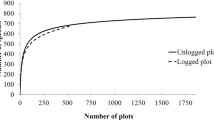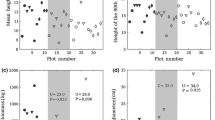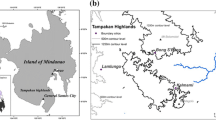Abstract
Reduced-impact logging (RIL) is known to be beneficial in biodiversity conservation, but its effects on tree diversity remain unknown. Pattern of tree diversity following disturbance usually varies with spatial scale of sampling (i.e., plot size). We examined the impacts of RIL on species richness and community composition of tree species at different spatial scales, and the scale (plot size) dependency of the two metrics; species richness versus community similarity. One 2-ha and three to four 0.2-ha plots were established in each of primary, RIL, and conventionally logged (CL) forest in Sabah, Malaysia. Species richness (the number of species per unit number of stems) was higher in the RIL than in the CL forest at both scales. The relationship between species richness and logging intensity varied with plot size. Species richness was greater in the RIL than in the primary forest at the 2-ha scale, while it was similar between the two forests at 0.2-ha scale. Similarly, species richness in the CL forest demonstrated a greater value at the 2-ha scale than at the 0.2-ha scale. Greater species richness in the two logged forests at the 2-ha scale is attributable to a greater probability of encountering the species-rich, small patches that are distributed heterogeneously. Community composition of the RIL forest more resembled that of the primary forest than that of the CL forest, regardless of plot size. Accordingly, species richness is a scale-dependent metric, while community similarity is a more robust metric to indicate the response of tree assemblage to anthropogenic disturbance.




Similar content being viewed by others
References
Akutsu K, Khen CV, Toda MJ (2007) Assessment of higher insect taxa as bioindicators for different logging-disturbance regimes in lowland tropical rain forest in Sabah, Malaysia. Ecol Res 22:542–550
Anderson MJ (2001) A new method for non-parametric multivariate analysis of variance. Austral Ecol 26:32–46
Asner GP, Knapp DE, Broadbent EN et al (2005) Selective logging in the Brazilian Amazon. Science 310:480–482
Azevedo-Ramos C, De Carvalho JrO, Do Amaral BD (2006) Short-term effects of reduced-impact logging on eastern Amazon fauna. For Ecol Manage 232:2635
Baker TR, Phillips OL, Malhi Y et al (2004) Variation in wood density determines spatial patterns in Amazonian forest biomass. Global Chang Biol 10:545–562
Barlow J, Gardner TA, Araujo IS et al (2007) Quantifying the biodiversity value of tropical primary, secondary, and plantation forests. Proc Natl Acad Sci USA 104:18555–18560
Berry NJ, Phillips OL, Ong RC et al (2008) Impacts of selective logging on tree diversity across a rainforest landscape: the importance of spatial scale. Landscape Ecol 23:915–929
Berry NJ, Phillips OL, Lewis SL et al (2010) The high value of logged tropical forests: lessons from northern Borneo. Biodiversity Conserv 19:985–997
Bertault JG, Sist P (1997) An experimental comparison of different harvesting intensities with reduced-impact and conventional logging in East Kalimantan, Indonesia. For Ecol Manage 94:209–218
Bicknell J, Peres CA (2010) Vertebrate population responses to reduced-impact logging in a neotropical forest. For Ecol Manage 259:2267–2275
Bischoff W, Newbery DM, Lingenfelder M et al (2005) Secondary succession and dipterocarp recruitment in Bornean rain forest after logging. For Ecol Manage 218:174–192
Blaser J, Sarre A, Poore D et al (2011) Status of tropical forest management. ITTO Technical Series 38. International Tropical Timber Organization, Yokohama
Brearley FQ, Prajadinata S, Kidd PS et al (2004) Structure and floristics of an old secondary rain forest in Central Kalimantan, Indonesia, and a comparison with adjacent primary forest. For Ecol Manage 195:385–397
Cannon CH, Peart DR, Leighton M et al (1994) The structure of lowland rainforest after selective logging in West Kalimantan, Indonesia. For Ecol Manage 67:49–68
Cannon CH, Peart DR, Leighton M (1998) Tree species diversity in commercially logged Bornean rainforest. Science 281:1366–1368
Castro-Arellano I, Presley SJ, Saldanha LN et al (2007) Effects of reduced impact logging on bat biodiversity in terra firme forest of lowland Amazonia. Biol Conserv 138:269–285
Chave J, Andalo C, Brown S et al (2005) Tree allometry and improved estimation of carbon stocks and balance in tropical forests. Oecologia 145:87–99
Chazdon RL, Colwell RK, Denslow JS et al (1998) Statistical methods for estimating species richness of woody regeneration in primary and secondary rain forests of Northeastern Costa Rica. In: Dallmeier F, Comiskey JA (eds) Forest biodiversity research, monitoring and modeling: conceptual background and old world case studies. Parthenon Publishing, Paris, pp 285–309
Chua LSL, Hawthorne WD, Guan SL et al (1998) Biodiversity database and assessment of logging impacts. In: Lee SS, Dan YM, Gauld ID et al (eds) Conservation, management and development of forest resources. Forest Research Institute Malaysia, Kuala Lumpur, pp 30–40
Condit R, Hubbell SP, Lafrankie JV et al (1996) Species-area and species-individual relationships for tropical trees: a comparison of three 50-ha plots. J Ecol 84:549–562
Connell JH (1978) Diversity in tropical rain forests and coral reefs. Science 199:1302–1310
Davis AJ (2000) Does reduced-impact logging help preserve biodiversity in tropical rainforests? A case study from Borneo using dung beetles (Coleoptera: Scarabaeoidea) as indicators. Environ Entomol 29:467–475
Dias MS, Magnusson WE, Zuanon J (2010) Effects of reduced-impact logging on fish assemblages in central Amazonia. Conserv Biol 24:278–286
Dumbrell AJ, Clark EJ, Frost GA et al (2008) Changes in species diversity following habitat disturbance are dependent on spatial scale: theoretical and empirical evidence. J Appl Ecol 45:1531–1539
Edwards DP, Larsen TH, Docherty TDS et al (2010) Degraded lands worth protecting: the biological importance of Southeast Asia’s repeatedly logged forests. Proc R Soc B-Biol Sci 278:82–90
Edwards DP, Woodcock P, Edwards FA et al (2012) Reduced-impact logging and biodiversity conservation: a case study from Borneo. Ecol Appl 22:561–571
Felton A, Wood J, Felton AM et al (2008) Bird community responses to reduced-impact logging in a certified forestry concession in lowland Bolivia. Biol Conserv 141:545–555
Foody GM, Cutler MEJ (2003) Tree biodiversity in protected and logged Bornean tropical rain forests and its measurement by satellite remote sensing. J Biogeography 30:1053–1066
Gibson L, Lee TM, Koh LP et al (2011) Primary forests are irreplaceable for sustaining tropical biodiversity. Nature 478:378–381
Gotelli NJ, Colwell RK (2001) Quantifying biodiversity: procedures and pitfalls in the measurement and comparison of species richness. Ecol Lett 4:379–391
Gutiérrez-Granados G, Pérez-Salicrup DR, Dirzo R (2011) Differential diameter-size effects of forest management on tree species richness and community structure: implications for conservation. Biodivers Conserv 20:1571–1585
Hall JS, Harris DJ, Medjibe V et al (2003) The effects of selective logging on forest structure and tree species composition in a Central African forest: implications for management of conservation areas. For Ecol Manage 183:249–264
Hamer KC, Hill JK (2000) Scale-dependent effects of habitat disturbance on species richness in tropical forests. Conserv Biol 14:1435–1440
Hasegawa M, Ito MT, Kitayama K et al. (2006) Logging effects on soil macrofauna in the rainforests of Deramakot Forest Reserve, Sabah, Malaysia. In: Lee YF, Chung AYC, Kitayama K (eds) Proceedings of the 2nd workshop on synergy between carbon management and biodiversity conservation in tropical rain forests. Forest Research Centre, Forestry Department, Sabah, pp 53–60
Hill JK, Hamer KC (2004) Determining impacts of habitat modification on diversity of tropical forest fauna: the importance of spatial scale. J Appl Ecol 41:744–754
Imai N, Samejima H, Langner A et al (2009) Co-benefits of sustainable forest management in biodiversity conservation and carbon sequestration. PLoS One 4:e8267
Johns JS, Barreto P, Uhl C (1996) Logging damage during planned and unplanned logging operations in the eastern Amazon. For Ecol Manage 89:59–77
Kirika JM, Bhning-Gaese K, Dumbo B et al (2010) Reduced abundance of late-successional trees but not of seedlings in heavily compared with lightly logged sites of three East African tropical forests. J Trop Ecol 26:533–546
Kleine M, Heuveldop J (1993) A management of planning concept for sustained yield of tropical forests in Sabah, Malaysia. For Ecol Manage 61:277–297
Lagan P, Mannan S, Matsubayashi H (2007) Sustainable use of tropical forests by reduced-impact logging in Deramakot Forest Reserve, Sabah, Malaysia. Ecol Res 22:414–421
Lawton JH, Bignell DE, Bolton B et al (1998) Biodiversity inventories, indicator taxa and effects of habitat modification in tropical forest. Nature 391:72–76
Lemmens RHMJ, Soerianegara I, Wong WC (1995) Timber trees: minor commercial timbers, plant resources South-east Asia 5(2). Backhuys Publishers, Leiden, p 655
Magurran AE (2004) Measuring biological diversity. Blackwell Science Ltd, Oxford, p 256
Makana JR, Thomas SC (2006) Impacts of selective logging and agricultural clearing on forest structure, floristic composition and diversity, and timber tree regeneration in the Ituri Forest, Democratic Republic of Congo. Biodivers Conserv 15:1375–1397
Medjibe VP, Putz FE, Starkey MP et al (2011) Impacts of selective logging on above-ground forest biomass in the Monts de Cristal in Gabon. For Ecol Manage 262:1799–1806
Miller SD, Goulden ML, Hutyra LR et al (2011) Reduced impact logging minimally alters tropical rainforest carbon and energy exchange. Proc Natl Acad Sci USA 108:19431–19435
Molino JF, Sabatier D (2001) Tree diversity in tropical rain forests: a validation of the intermediate disturbance hypothesis. Science 294:1702–1704
Oey DS (1951) Perbandingan berat dari djenis2 kaju Indonesia dan pengartian beratnja kaju untunk keperluan praktek. Penjelidikan Kehutanan, Bogor, p 183
Okuda T, Suzuki M, Adachi N et al (2003) Effect of selective logging on canopy and stand structure and tree species composition in a lowland dipterocarp forest in peninsular Malaysia. For Ecol Manage 175:297–320
Ouédraogo DY, Beina D, Picard N et al (2011) Thinning after selective logging facilitates floristic composition recovery in a tropical rain forest of Central Africa. For Ecol Manage 262:2176–2186
Peña-Claros M, Fredericksen TS, Alarcón A et al (2008) Beyond reduced-impact logging: silvicultural treatments to increase growth rates of tropical trees. For Ecol Manage 256:1458–1467
Pinard MA, Putz FE (1996) Retaining forest biomass by reducing logging damage. Biotropica 28:278–295
Plumptre AJ (1996) Changes following 60 years of selective timber harvesting in the Budongo Forest Reserve, Uganda. For Ecol Manage 89:101–113
Presley SJ, Willig MR, Wunderle JM Jr et al (2008) Effects of reduced-impact logging and forest physiognomy on bat populations of lowland Amazonian forest. J Appl Ecol 45:14–25
Putz FE, Sist P, Fredericksen T et al (2008a) Reduced-impact logging: challenges and opportunities. For Ecol Manage 256:1427–1433
Putz FE, Zuidema PA, Pinard MA et al (2008b) Improved tropical forest management for carbon retention. PLoS Biol 6:e166
Rockwell CA, Kainer KA, Staudhammer CL et al (2007) Future crop tree damage in a certified community forest in southwestern Amazonia. For Ecol Manage 242:108–118
Rodrigues ASL, Andelman SJ, Bakan MI et al (2004) Effectiveness of the global protected area network in representing species diversity. Nature 428:640–643
Sabah Forestry Department (2005) Forest management plant 2. Deramakot Forest Reserve, Forest management unit no. 19, Sandakan
Samejima H, Ong R, Lagan P et al (2012) Camera-trapping rates of mammals and birds in a Bornean tropical rainforest under sustainable forest management. For Ecol Manage 270:248–256
Seino T, Takyu M, Aiba SI et al. (2006) Floristic composition, stand structure, and above-ground biomass of the tropical rain forests of Deramakot and Tangkulap Forest Reserve in Malaysia under different forest managements. In: Lee YF, Chung AYC, Kitayama K (eds) Proceedings of the 2nd workshop on synergy between carbon management and biodiversity conservation in tropical rain forests. Forest Research Centre, Forestry Department, Sabah, pp 29–52
Sheil D, Burslem DFRP (2003) Disturbing hypotheses in tropical forests. Trends Ecol Evol 18:18–26
Sist P, Nolan T, Bertault JG et al (1998) Harvesting intensity versus sustainability in Indonesia. For Ecol Manage 108:251–260
Slik JWF (2006) Estimating species-specific wood density from the genus average in Indonesian trees. J Trop Ecol 22:481–482
Slik JWF, Verburg RW, Keßler PJA (2002) Effects of fire and selective logging on the tree species composition of lowland dipterocarp forest in East Kalimantan, Indonesia. Biodivers Conserv 11:85–98
Soerianegara I, Lemmens RHMJ (1993) Timber trees: major commercial timbers, Plant Resources South-east Asia 5(1). Backhuys Publishers, Leiden, p 605
Sosef MSM, Hong LT, Prawirohatmodjo S (1998) Timber trees: lesser-known timbers, Plant Resources South-east Asia 5(3). Backhuys Publishers, Leiden, p 859
Souza AF, Cortez LSR, Longhi SJ (2012) Native forest management in subtropical South America: long-term effects of logging and multiple-use on forest structure and diversity. Biodivers Conserv 21:1953–1969
Su JC, Debinski DM, Jakubauskas ME et al (2004) Beyond species richness: community similarity as a measure of cross-taxon congruence for coarse-filter conservation. Conserv Biol 18:167–173
Verburg R, Van Eijk-Bos C (2003) Effects of selective logging on tree diversity, composition and plant functional type patterns in a Bornean rain forest. J Veg Sci 14:99–110
Webb EL, Peralta R (1998) Tree community diversity of lowland swamp forest in Northeast Costa Rica, and changes associated with controlled selective logging. Biodivers Conserv 7:565–583
Whittaker RH (1960) Vegetation of the Siskiyou Mountains, Oregon and California. Ecol Monogr 30:279–338
Wright SJ (2005) Tropical forests in a changing environment. Trends Ecol Evol 20:553–560
Wunderle JM Jr, Henriques LMP, Willig MR (2006) Short-term responses of birds to forest gaps and understory: an assessment of reduced-impact logging in a lowland Amazon forest. Biotropica 38:235–255
Acknowledgments
This study was supported by the Global Environment Research Fund F-071 and D-1006 of the Ministry of the Environment, Japan, to KK. We thank D. K. M. Esther for assisting research plot establishment, M. Poster and D. Joel for tree species identification, R. Ajon and many other persons for assisting field survey, R. Aoyagi, A. Langner and A. Tanaka for remote sensing analysis, P. Lagan for generous support for every aspect. We acknowledge the kind assistance from Sabah Forestry Department and Forest Research Centre, Sabah.
Author information
Authors and Affiliations
Corresponding author
Rights and permissions
About this article
Cite this article
Imai, N., Seino, T., Aiba, Si. et al. Effects of selective logging on tree species diversity and composition of Bornean tropical rain forests at different spatial scales. Plant Ecol 213, 1413–1424 (2012). https://doi.org/10.1007/s11258-012-0100-y
Received:
Accepted:
Published:
Issue Date:
DOI: https://doi.org/10.1007/s11258-012-0100-y




